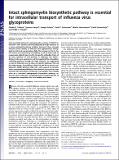| dc.contributor.author | Ploegh, Hidde | |
| dc.contributor.author | Tafesse, Fikadu G. | |
| dc.contributor.author | Sanyal, Sumana | |
| dc.contributor.author | Ashour, Joseph | |
| dc.contributor.author | Guimaraes, Carla P. | |
| dc.contributor.author | Hermansson, Martin | |
| dc.contributor.author | Somerharju, Pentti | |
| dc.date.accessioned | 2014-02-14T15:19:03Z | |
| dc.date.available | 2014-02-14T15:19:03Z | |
| dc.date.issued | 2013-04 | |
| dc.date.submitted | 2012-11 | |
| dc.identifier.issn | 0027-8424 | |
| dc.identifier.issn | 1091-6490 | |
| dc.identifier.uri | http://hdl.handle.net/1721.1/84947 | |
| dc.description.abstract | Cells genetically deficient in sphingomyelin synthase-1 (SGMS1) or blocked in their synthesis pharmacologically through exposure to a serine palmitoyltransferase inhibitor (myriocin) show strongly reduced surface display of influenza virus glycoproteins hemagglutinin (HA) and neuraminidase (NA). The transport of HA to the cell surface was assessed by accessibility of HA on intact cells to exogenously added trypsin and to HA-specific antibodies. Rates of de novo synthesis of viral proteins in wild-type and SGMS1-deficient cells were equivalent, and HA negotiated the intracellular trafficking pathway through the Golgi normally. We engineered a strain of influenza virus to allow site-specific labeling of HA and NA using sortase. Accessibility of both HA and NA to sortase was blocked in SGMS1-deficient cells and in cells exposed to myriocin, with a corresponding inhibition of the release of virus particles from infected cells. Generation of influenza virus particles thus critically relies on a functional sphingomyelin biosynthetic pathway, required to drive influenza viral glycoproteins into lipid domains of a composition compatible with virus budding and release. | en_US |
| dc.description.sponsorship | National Institutes of Health (U.S.) (R01 Award AI033456) | en_US |
| dc.description.sponsorship | National Institutes of Health (U.S.) (R01 Award AI087879) | en_US |
| dc.language.iso | en_US | |
| dc.publisher | National Academy of Sciences (U.S.) | en_US |
| dc.relation.isversionof | http://dx.doi.org/10.1073/pnas.1219909110 | en_US |
| dc.rights | Article is made available in accordance with the publisher's policy and may be subject to US copyright law. Please refer to the publisher's site for terms of use. | en_US |
| dc.source | PNAS | en_US |
| dc.title | Intact sphingomyelin biosynthetic pathway is essential for intracellular transport of influenza virus glycoproteins | en_US |
| dc.type | Article | en_US |
| dc.identifier.citation | Tafesse, F. G., S. Sanyal, J. Ashour, C. P. Guimaraes, M. Hermansson, P. Somerharju, and H. L. Ploegh. “Intact sphingomyelin biosynthetic pathway is essential for intracellular transport of influenza virus glycoproteins.” Proceedings of the National Academy of Sciences 110, no. 16 (April 16, 2013): 6406-6411. | en_US |
| dc.contributor.department | Massachusetts Institute of Technology. Department of Biology | en_US |
| dc.contributor.department | Whitehead Institute for Biomedical Research | en_US |
| dc.contributor.mitauthor | Ploegh, Hidde | en_US |
| dc.relation.journal | Proceedings of the National Academy of Sciences | en_US |
| dc.eprint.version | Final published version | en_US |
| dc.type.uri | http://purl.org/eprint/type/JournalArticle | en_US |
| eprint.status | http://purl.org/eprint/status/PeerReviewed | en_US |
| dspace.orderedauthors | Tafesse, F. G.; Sanyal, S.; Ashour, J.; Guimaraes, C. P.; Hermansson, M.; Somerharju, P.; Ploegh, H. L. | en_US |
| dc.identifier.orcid | https://orcid.org/0000-0002-1090-6071 | |
| mit.license | PUBLISHER_POLICY | en_US |
| mit.metadata.status | Complete | |
